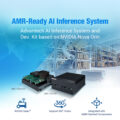~ A guide to selecting the ideal testing solution for your application ~
From testing wind turbines to ensuring telecoms infrastructure stays online during power outages, load banks play a wide and varied role in keeping the country running. But knowing which load bank to choose can be difficult. Here, Andrew Keith, division director of load bank manufacturer Power Prove, explores the main differences between fixed and portable load banks and offers his advice on choosing a testing solution tailored to an application’s needs.
At the surface level, the difference between portable and fixed load banks is straightforward — one can be moved between testing sites and the other cannot. However, there are several important differences when it comes to their benefits, so it’s important to consider carefully which type would be better suited to your application.
Before investing in either solution, make sure you have a good idea of the continuous power requirements of the equipment you plan to test. You should also ask yourself where you plan to use the load bank, as well as what your budget is. Having a clear answer to each of these questions will ensure that you make the right purchasing decision.
Fixed load banks
Installing a permanent load bank offers several advantages, especially when it comes to locations that require regular testing of backup generators, such as hospitals and industrial plants. This also includes data centres, which will soon be classified as critical national infrastructure, highlighting the importance of ensuring their operation even during power outages and extreme weather events.
Permanent solutions are often preferable to portable load banks when testing equipment with high continuous power requirements located in hard-to-reach locations. Furthermore, not only does adding a fixed load bank mean that the testing equipment is available whenever it is needed, providing flexibility for maintenance schedules and diagnostics but it can also be more cost-effective when compared to the cost of hiring a crane to lift a high-power load bank onto a roof or installing long cable run to a load bank far from the generator.
Fixed load banks can either be freestanding, self-cooled solutions or be installed in the air outlet between the generator’s radiator and acoustic splitters, which can save you from having to buy separate fans and ventilation systems. Mounting load banks to radiators does not create any additional noise, which is essential for applications where noise control is an important consideration.

Portable load banks
If you’re looking to use a load bank over a wide range of different locations, opting for a portable load bank could be the solution. Businesses offering generator testing services could find compact light-weight load banks the perfect to carry in the service vans to conduct testing as and when required.
For example, load bank testing plays a key role in the quality control process of new electric vehicle (EV) charging points. The target to roll out 300,000 new charging points across the UK by 2030 means that engineers will need to carry out testing at thousands of sites, making a portable load bank ideal. Other uses for portable load banks include performing pre-commissioning tests on offshore renewable systems. Given that these locations are hard to access, easy manoeuvrability is useful.
For these kinds of multi-site applications, where the power generation source is accessible portable load banks can save money by eliminating the need for installation costs at every location.

While it’s true that portable options often have a lower capacity to handle power demands than fixed load banks, choosing a custom design means that flexibility does not have to come at the expense of capacity. Tailormade load banks can be designed to provide higher capacity in a compact, easy-to-handle package.
Power Prove has extensive experience in designing and producing custom and off-the-shelf load banks for applications including renewables and generator testing. We offer a range of customisation options, including portability, digital interfaces and remote testing.
The uses of load bank testing are wide ranging, meaning there will be no one-size-fits-all solution when it comes to finding the perfect load bank. Knowing whether a portable or fixed load bank would be best suited to your needs will go a long way in ensuring an optimised testing setup.
To find the right load bank for your application, contact Power Prove’s expert team.







